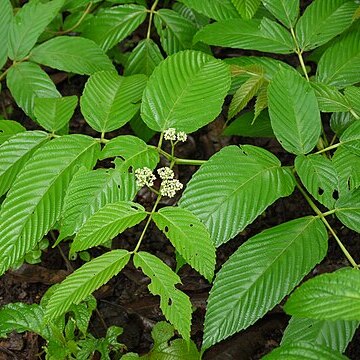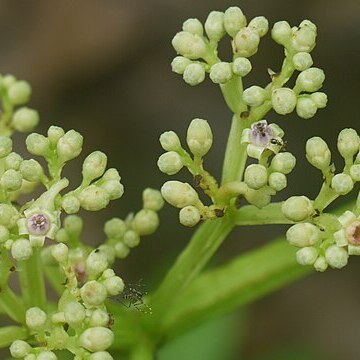Erect shrubs or small trees. Branchlets terete with longitudinal ridges obtuse, sparsely pubescent. Leaves pinnate or 3-foliolate; stipules deciduous; petiole 3-7 cm, central petiolules 3-6 cm, lateral petiolules 0.7-2.5 cm, pubescent or subglabrate; leaflets oblong, ovate-elliptic, or long ovate, 8-22 × 4-13 cm, base rounded or slightly cordate, margin with rounded and obtuse teeth, apex acuminate or caudate, abaxial surface sparsely with scabrous hairs on veins to sometimes pubescent, adaxial surface glabrous or with sparse bristles on veins; lateral veins 11-15 pairs, adaxial veinlets conspicuously protruding. Inflorescences leaf-opposed, compound dichasial, usually branched at base; peduncle 1.2-2 cm, sparsely pubescent. Involucre narrow, triangular, 0.3-0.5 cm; bracts small, long triangular, 1.5-2 × 0.4-0.6 cm, glabrous. Pedicel 1-2 mm, with papillate hairs; buds ovate-elliptic, 2-3 mm, apex rounded. Calyx tube cupulate, margin undulately lobed. Petals elliptic, 1.5-2.5 mm, glabrous. Staminodial tube 1.2-1.5 mm, with lower part 0.2-0.25 mm, upper 1-1.2 mm, lobes 0.5-0.7 mm. Stamens 5; filaments 0.8-1.2 mm; anthers elliptic, 0.8-1 × 0.4-0.5 mm. Ovary globose; style 0.8-1 mm; stigma expanded slightly. Berry oblate, 0.5-0.7 cm, 4-6-seeded. Fl. Apr-Jul, fr. Aug-Dec. 2n = 48.
More
An erect shrub. It grows to about 1 m high. The leaves have stalks. They are twice divided. The upper leaves have 5-7 leaflets. The leaflets are 7.5-20 cm long. They taper to the tip. They are oblong with teeth around the edge. The flowers are white with a yellow tinge. The fruit is a berry. It is green.


